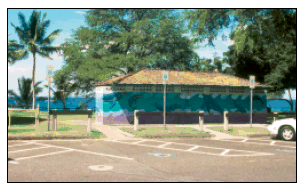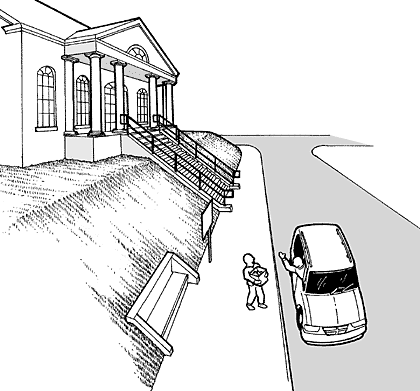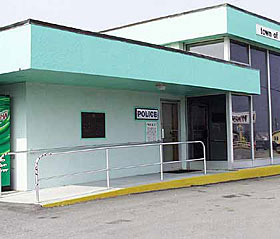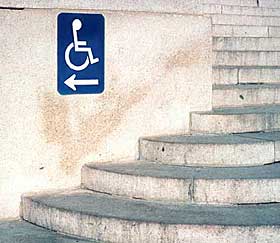1. Existing Facilities: Program Accessibility.
When programs, services, or activities are located in facilities that existed prior to January 26, 1992, the effective date of title II of the ADA, towns must make sure that they are also available to persons with disabilities, unless to do so would fundamentally alter a program, service, or activity or result in undue financial or administrative burdens (see page 8). This requirement is called program accessibility. When a service, program, or activity is located in a building that is not accessible, a small town can achieve program accessibility in several ways. It can:
• relocate the program or activity to an accessible facility,
• provide the activity, service, or benefit in another manner that meets ADA requirements, or
• make modifications to the building or facility itself to provide accessibility. Thus, to achieve program accessibility, a small town need not make every existing facility accessible. It can relocate some programs to accessible facilities and modify other facilities, avoiding expensive physical modifications of all town facilities.

Physical modifications to provide program accessibility included parking spaces, the public toilet facility and an accessible route to the ocean overlook.
Example
A town holds its annual town meeting in an inaccessible location, the second floor of the two-story town hall that has no elevator. The town council considers installing an elevator in the building as well as replacing the existing town hall with a new, fully accessible building, but determines that the town’s limited financial resources will not allow either of these approaches. Instead, the town officials decide to hold the town meetings, as well as other public meetings where large numbers of the public are expected to attend, in the accessible auditorium of its local high school. The town officials also decide to move smaller meetings, which are periodically held on the second floor of the town hall, to the school auditorium, when they receive a request within 24 hours of a meeting.
Example
The town library is a historic structure that is listed on the State historic register. The two entrances to the facility each have four steps and no accessible entrance is provided. The town consults with an architect to determine if an accessible entrance can be provided and is told that a ramp or lift cannot be added to either entrance without a significant change to the exterior of the building. After reviewing the ADA requirements, the town learns that qualified historic buildings and facilities are not required to take any action that would threaten or destroy the historic significance of a historic property. The State historic preservation office is consulted and it determines that the exterior cannot be modified. Because physical modifications to the entrances cannot be made, the town changes its policies and provides access to the library services in an “alternate manner” upon request. Library staff are trained to take requests over the telephone, to look up information for individuals with disabilities who cannot use the library, to provide information over the telephone, and to provide curbside service for books and library publications or to mail items to individuals upon request. Library staff may also meet with an individual in another accessible location when the telephone service is not effective. The library publicizes a telephone number for requesting these alternate services in its publications and announcements.

Library staff provide curbside services because the library facility cannot be made accessible.
Example
A town-operated two story historic house museum, which dates from 1885, provides exhibition and instructional programs for the public. The focus of the program is the exhibition of a typical 19th century Victorian house.
The self-evaluation determines that the house is not accessible. After considering the options for providing access to the programs and services, the town decides that it is not possible to move the museum programs to other accessible locations because the historic house itself is a critical part of the historic house program. The town develops plans to alter the facility to provide physical access to the first floor. These alterations are planned in compliance with the historic preservation requirements of the ADA Standards.
After reviewing the alterations with the State historic preservation office, the town determines that the second floor cannot be made accessible without threatening the unique features and historic significance of the house. Because the town must consider alternatives to structural changes in these instances, the town establishes a policy to locate all temporary programs on the first floor. In addition, the town documents the second floor spaces and content using video or other innovative solutions and provides an accessible viewing area on the first floor.
Example
The town's police station has one step at the public entrance and there is no accessible entrance available. After considering its options for providing program accessibility, the town decides to modify the facility to provide access rather than relocate the police programs or services. After review of the programs and services provided at the station, the town determines that the public entrance, lobby, and service counter need to be accessible to provide program accessibility. Therefore, alterations are limited to those items necessary to achieve program accessibility. In this case, it includes providing a van-accessible parking space in the parking lot, an accessible route from the parking space to the modified public entrance, and an accessible service counter inside the police station.

A town chose to alter its police station rather than move its programs and services to another accessible location.
When a town becomes aware that a program is not accessible and plans to alter a facility to provide access, it may be necessary to temporarily relocate a program, service, or activity to a temporary accessible location or to temporarily offer the service in an alternate manner.
This temporary solution assures that the service, program, or activity is accessible during the time the alterations are planned and being implemented.
Example
The public toilet facilities at the town recreation area are not accessible. After consideration of whether to modify the facilities or to relocate the programs held at the recreation area, the town decides to alter the toilet facilities and the walkway leading to them. While the fundraising is done, alterations planned, and the work completed, the town provides temporary portable toilet facilities that are accessible.
When choosing a method of providing program access, a public entity must give priority to the one that results in the most integrated setting appropriate to encourage interaction among all users, including individuals with disabilities. In addition, a town may offer additional activities or services so an individual with a disability can more fully participate in, or benefit from, a program, service, or activity. However, when such special activities or services are provided for people with disabilities, the town must permit a person with a disability to choose to participate in services, programs, or activities that are not different or separate.
Example
The local town pool provides a swimming program for people with disabilities that includes additional staff who provide individualized instruction. A person with a disability participates in the program. The person applies to attend group swimming lessons that are open to the public even though these lessons do not provide specialized instruction. The town must permit the individual with a disability to participate unless doing so would fundamentally alter the program
Because program accessibility may be provided in an accessible part of a facility when the remainder of the facility is not accessible, the public must be informed of the location of accessible features. Signs should direct the public to the location of accessible elements and spaces, including the location of accessible parking, the accessible entrance to a facility, and accessible toilet rooms. In addition, a town may issue a brochure or pamphlet with a map indicating the town's accessible features.
Example
A town hall has two sets of public toilet rooms. One set has been altered and is accessible, and the other set is not accessible. The town installs signage at the inaccessible toilet rooms directing people to the accessible toilet rooms.

Sign at an inaccessible entrance provides directions to the nearest accessible entrance
Towns making modifications to a building or facility to provide program accessibility must comply with the ADA Standards for Accessible Design (ADA Standards) or the Uniform Federal Accessibility Standards (UFAS).

User Comments/Questions
Add Comment/Question